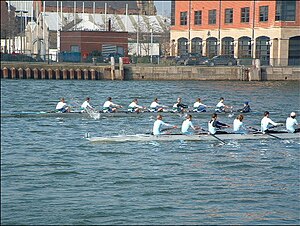Going on camp is fun and a great investment in your fitness and rowing skills. And for coaches it’s an opportunity to train without the pressures of athletes leaving on time for work or school as well as still water for testing and crew selection.
For athletes: You have to prepare yourself for the extra training you’ll do on camp – for club athletes the workload is heavier than normal and usually you have a few days rest or landtraining before camp starts because your boats are on a trailer and you’re travelling.
 Queen’s University B.C overtaking UCD B.C at Lagan Head of the River 2003. (Photo credit: Wikipedia)
Queen’s University B.C overtaking UCD B.C at Lagan Head of the River 2003. (Photo credit: Wikipedia)
For coaches: You have to plan the whole camp so you get everything you want to do completed, plus have a bad weather backup plan so that when you get home you have actionable results to work on for the next period of training.
Athletes prepare for rowing camp
The first thing that suffers on camp are your hands . The skin wears out and you get blisters and sores. There are a range of things you can do
- Get in a few long rows in advance before you leave – increase your training load in the boat. I find rowing in a 1x is better for hand callous development than in crew boats
- Take blister remedies with you on camp (pumice stone to rub down callouses, tape, rowing gloves are a great back-stop for when your hands need protecting for a couple of rows)
- You will also get a sore backside and possibly calves. So consider your clothing – leggings / long socks / calfskins / knickers
- Buy the e book “Rowing blisters and skin injuries” for straightforward advice
Next think about the weather
- Sun care – lots of camps are ruined because by day 3 people are sunburned and as a result feel ill and row slow.
- What clothing should you pack? Allow 3 changes of rowing kit per day plus evening clothing. Have enough layers for two outings on wet / cold days so you can put on dry clothes before each session.
Lastly food
- Food when overseas. Frequently camps start during public holidays (New Year / Easter). Think about your travelling time, what meals do you need when you arrive and during the trip. Where you can get food at your destination and when can you buy food? Over the new year – shops may be shut from Christmas through to 6th January (in Catholic countries when Twelfth Night celebrates the end of the religious holiday).
- Take the first day’s food take with you – including evening meal and breakfast.
Coaches prepare for rowing camp
It never ceases to amaze me how many coaches go on camp unprepared. A plan for the camp is a pre-requisite – without it you are wasting your time and your athletes’. Read Duncan Holland’s ebook on How to run Seat Racing.
- Write a training programme in advance
- Finish the camp with a race that approximates the next big event you will do – the Eights Head if you’re in UK
- Even if you are doing seat racing during the camp – still finish with a race to check your selections are correct
- Programme a half a days rest in advance of the race
- Run the race on prognostic times (link is to the ebook)
Suggestions for competitive training sessions / races which you could run
- 6 x 500 m raced in groups of 3 in singles and whoever won went up a group to race the next round in a faster group and who lost went down. This enables all athletes to find their level and integrate different boat speeds into the same competition
- Or 3 x 1000 meters as above
- 3 x 2,000 meters with 1km at rate 24 adn 1km at rate 26; second race 1km at rate 26 then 28; third race 28 and 30. You need a half-way timing point so you can calculate if the crews are gaining boat speed when they also go up in rate
- Head race or ergo test of 5 km having weighed the athletes so you can compare weight adjusted times [use our Ergo Weight Adjustment spreadsheet]






